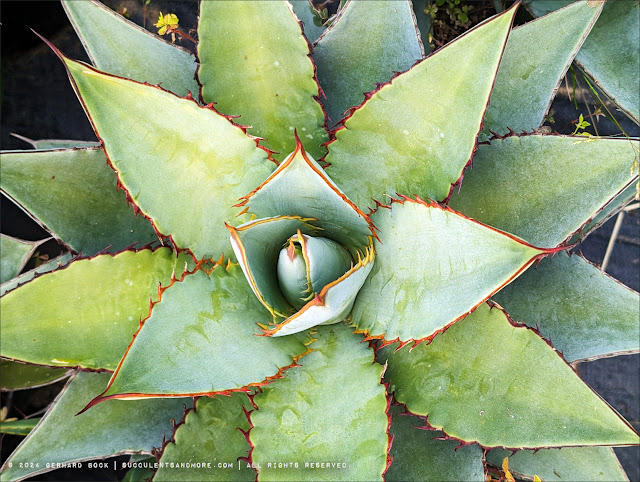Agave edema is real
On my Santa Barbara trip last week, I bought some plants from Nick Deinhart, including this spectacular Mangave ‘Bloodspot’ × Agave ‘Blue Glow’ cross for my friend Kyle:
 |
| Mangave ‘Bloodspot’ × Agave ‘Blue Glow’ when I picked it up from Nick Deinhart |
I loaded my new plants into the car on Friday afternoon when it was about 60°F and sunny. I spent the night in Pismo Beach, less than a mile from the ocean. Overnight, it cooled off to the mid-50s, and it was overcast and somewhat damp when I left on Saturday morning on my drive home. The weather remained cool and overcast for the next hour before the fog lifted and the sun came out. For the remainder of the trip, it was bright and sunny, the temperature climbing into the low 80s by mid-afternoon. I arrived home at around 3 p.m. I had the air conditioning in the car set to 68°F the entire time, except for two quick bathroom breaks when the engine was off, and the air in the car heated up into the 80s.
I unloaded the plants right after I got home and set them in the shade on the north side of the house. So far so good. Except the following morning, I was greeted by this sad sight:
 |
| The same plant the morning after I got home |
When you look at these photos, you get an idea of how devastated I was.
The damage you see is a classic case of agave edema. It can occur when a plant experiences a sudden change in temperature, humidity and/or light levels – like from 55°F and damp on the Central Coast to 80°F and dry in the Sacramento Valley. This phenomenon is well-known to growers who transport agaves and other succulents in closed delivery trucks or trailers.
In a 2016 Facebook thread started by Loree danger garden Bohl on this very topic, agave expert Greg Starr of Starr Nursery in Tucson said: “I attribute the damage to the process of respiration being interrupted very suddenly, causing the stomates to shut rapidly and not allowing gas exchange to slow normally, thereby causing the surrounding cells to burst from a ‘gas overload’. I think [the cause is] primarily a light-dark change frequently in conjunction with a change in temperature. I have noticed this happen more when transporting plants from a cooler to hotter location, but that is not consistent.” (To see more responses to this Facebook thread, read Loree’s original post.)
I’ve written about this before, for example in this post about a newly purchased Agave guadalajarana ‘Leon’ being similarly afflicted:
 |
| Agave guadalajarana ‘Leon’ with similar damage (September 2013) |
There’s really not much you can do to prevent this kind of damage. In addition, it seems that not all plants are equally susceptible to edema. Out of the 10+ agaves and mangaves I brought home from my Santa Barbara trip, only that one showed extensive damage. One, a variegated Agave shawii, had some minor damage on one leaf. The others were completely fine. The only pattern I can see is that the mangave with the most damage has relatively light-colored leaves; the others have darker leaves. Is that what made the difference between OK and not OK? I simply don’t know.
One thing I do know: The damage, while cosmetic, is permanent. Over time, the plant will outgrow the damage, but for a few years, it won’t win any beauty contests.
Back to Kyle’s disfigured Mangave ‘Bloodspot’ × Agave ‘Blue Glow’: After watching my video of Tony Krock’s agave coring and cutting demonstration, Kyle felt inspired to try it himself. He figured he had nothing to lose – and possibly a half a dozen or dozen pups to gain. Here’s the result:
 |
| First Kyle cut out the center of the plant... |
 |
| ...then he sawed the plant and root ball in half |
 |
| Cut halves |
 |
| Kyle even removed the immature leaves above the meristem as per Tony’s recommendation. Pups should form along the meristem (below the arrow). |
I’ll post an update if and when Kyle’s plant starts to make pups.
© Gerhard Bock, 2024. All rights reserved. To receive all new posts by email, please subscribe here.



I am sorry to hear what happened to Kyle's Agave. It will be interesting to see how long it takes to develop the pups. A good solution to an unfortunate occurrence!
ReplyDeleteI'm hoping that with the warm weather pups will form quickly. In the meantime, I'm looking for a suitable candidate in my garden. I really want to give it a try.
DeleteOh, I'm sorry about the plant damage. But the timing of this couldn't have been better. I look forward to seeing the results!
ReplyDeleteI know! Perfect timing. I'll definitely keep y'all posted. I hope Kyle will get plenty of offsets. I wouldn't mind having one myself :-)
DeleteSuch a freaky thing, I would find it hard to believe if I hadn't experienced it myself.
ReplyDeleteUgh! Having experienced it myself, I feel your pain (and Kyle's). Your supposition about the color of the affected plants is interesting. In my garden, it was a large clump of Agave attenuata that was impacted the most severely but a light-colored Agave colorata was also affected. The Mangave- Agave hybrid was a beauty and I hope the surgery Kyle performed yields a plethora of perfect pups.
ReplyDeleteThat is a very brave move. This will be exciting to see. I hope it works out!
ReplyDeleteI just got one for Mother's Day. we have got lots of rain, so set it on my balcony. Don't know how well it would grow in Arkansas. We'll see plus it's very hot here in the summer.
ReplyDelete